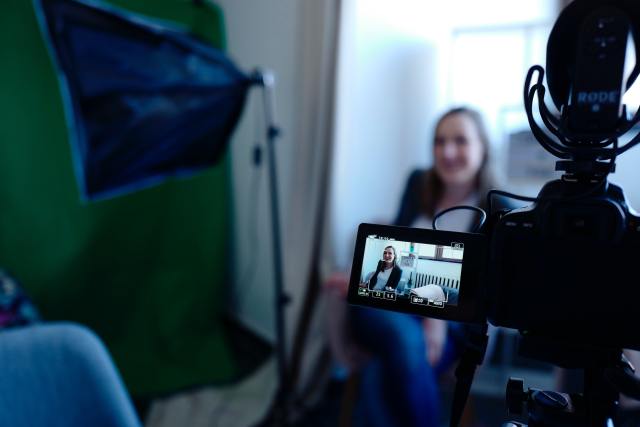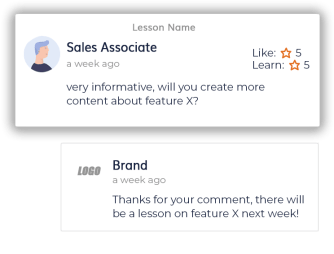5 Key Tips for Creating Effective Training Videos

At Myagi, we love video. We know it’s the best way to quickly deliver detailed information to staff, equipping them with the tools they need to provide incredible customer experiences. But just because it can, doesn’t mean it always will—videos aren’t magic (though good editing they can give that impression), and a poorly-planned video can even hinder staff education.
We’ve previously given advice about equipment for making videos and filming without professional gear, but now we’re getting into the good stuff: the content itself. Here are five vital things to remember when starting to create training videos, to ensure that frontline staff are able to make the most out of the information you’re presenting them.

1. Keep It Brief
Though today’s attention spans are not as abysmal as they’ve been made out to be, it’s true that shorter content performs better on online platforms and in the minds of potentially distractible sales associates. When it comes to instructional or explainer videos, the rate of audience retention is linked to video length, with 1-2 minutes being the ideal length for keeping viewers engaged, and anything longer showing a significant drop in audience retention. While that doesn’t sound very long, it’s the perfect amount of time to deliver bite-sized pieces of key information that frontline staff will be able to remember and reproduce accurately when speaking to customers.

As much as we may wish our staff would take detailed, colour-coded notes and pay close attention to hour-long sessions about retail execution plans, this is both unrealistic and impractical for delivering the sort of knowledge that sales associates need to have ready on the shop floor. ‘Bite-sized’ is the keyword here—memorable snippets in chunks of relevant content is the best format to ensure staff find training accessible and engaging, instead of tedious and overwhelming.
Keeping videos under 2 minutes also helps prioritise what needs to be included: a rambling introduction or extensive technical information that is probably outside the grasp (or at least the interest) of most customers might not be the best way to spend sales associates’ time, even if it seems beneficial when planning the video. But remember, the 2-minute length is advice, not a rule, so apply it with common sense: sometimes a longer or shorter video is suitable for the amount of information that should be conveyed at once. To ensure long videos are used only when necessary, try to divide up content into relevant sections rather than spilling everything about multiple categories at once. This helps keep things clearer in the minds of staff and improves the accuracy of knowledge shared with customers.
2. Don’t Stress About Production Value
We’ve found that videos with lower production value actually perform better amongst shop floor staff, as users find the content more authentic. Fleet Feet’s Retail Operations Trainer Kate Stone has recognised this as well, and advises content creators not to complicate their videos or worry about polished production in favour of keeping videos relatable. As long as the sound is clear, the rest of the video doesn’t need to be polished to be effective. Relatability and authenticity can help improve communications between company headquarters and frontline sales staff, while encouraging higher engagement with training content.

3. Educational Doesn’t Mean Boring
You’ve got your camera and lighting set up ready to record a training video. You’ve practiced the script, tested the mic, and with product in hand it’s “lights, camera, action!” You rattle off the information, but watching the video back you realise you’ve just talked monotonously into the camera for a few minutes, and everything you said has melted into a jumble of words; even your own eyes are drifting from the screen. What happened?! Isn’t video engaging?
It can be, and sometimes these straightforward videos are enough to get your message across. But it helps to mix things up a bit, especially since video lets us show and not just tell. Making the most of visual elements keeps viewers engaged and improves learning by connecting information to what they can see. It also helps you keep video length down, as more information can be conveyed faster through visuals.
Keeping videos interesting can mean something as minor as editing in product close-ups, or shots of product features in action. If possible, you could take the product out and demo it in its intended setting, a tactic that CASIO UK employ frequently in training videos about their technical watches, to great success and positive feedback from Myagi users. Demonstrating products in action gives staff a visual reference for understanding features and specs, making it easier to recall and explain when being queried by customers on the shop floor.

Another way to liven up videos through editing is to put key information on screen in bullet-points, an effective method of emphasizing the important points sales associates should be taking from the video. This also lets you add some style while giving viewers somewhere to focus their eyes, limiting distraction.
If editing isn’t your thing, or time constraints make it tricky to do more than the basics, then you can keep training videos interesting by getting different people to feature in videos. Jeff from product development is excited about this new feature? Get him to talk about it in the next training piece! Got an expert salesperson in the office? Diversify your content by ending with some sales tips to give sales associates confidence in their ability to convey the right message to customers. You can even collaborate with your brand partners, like RAB and Polartec have been doing to strengthen and consolidate their message around product technologies. Making videos interesting can be as simple as including a joke or making an effort to be dynamic in your presentation—just make sure there’s some diversity in your content if you really want to grab staff’s attention over time.
4. Make It a Two-Way Street
We know a training video isn’t a Skype call, but that doesn’t mean you can’t make videos a place for opening communication. By giving staff the opportunity to comment on their training and provide feedback, you in turn receive a valuable opportunity to tailor content to the users who need it to help them get the most out of their learning. Whether it’s answering questions and providing clarifications about what was featured in a video, taking suggestions for future training content, or general feedback about the presentation of information—giving employees a say in their learning is extremely beneficial for them and for your company, as it ensures resources are being put to their best use while improving the brand-to-retailer relationship.

Encourage users to leave feedback, and take their thoughts into consideration. You can incentivise staff by running competitions, a method employed CASIO UK in preparation for the holiday season. CASIO UK requested ideas for new training videos through Myagi, offering a watch of choice as reward for the best concept, which was made into a reality as part of the prize. If sales associates feel personally invested in their training with the opportunity to provide input, they’re more likely to engage over time and pay better attention to information, as well as relate positively to the brands they’re selling.
5. Follow Up
You might have made the perfect training video, but effectively educating sales staff doesn’t end there. It is vital to reinforce training and follow up on staff education to ensure that sales associates can retain what they’ve learned accurately over time. Without reinforcement, you can expect staff to have forgotten 90% of training information within a week of it being delivered. Considering all the resources spent on product development, distribution, marketing, creating and delivering training content, letting 90% of knowledge go to waste by not following up poses a significant cost and is a sure way to miss out on sales.
One of the best ways to reinforce learning is to follow up a video straight away with some quiz questions. Testing is not just a tool for assessing learning, but an important part of actually improving learning, as it strengthens the connections in our brain that help us remember information beyond the short-term. Providing a document summarising key information from the video is another way of reinforcing knowledge—this might be less effective at stimulating memory synapses than testing, but documents can be useful for things like technical product specifications, as they provide sales associates with a resource that can be referred back to when necessary.

Another important method of following up is highlighting key information again when relevant, be it in time with product launches, marketing campaigns or seasonal promotions. This can be achieved by re-announcing previous content when it becomes relevant again so that users are notified, or making sure that key knowledge and sales tips get included in new content as it’s rolled out.

Want to find out more about how you can improve how you deliver training content to drive sales and create incredible customer experiences? Visit myagi.com to book a product demo or speak to a member of our team!


